March 2020 LIP of the Month
Large Igneous Provinces and Devonian Biotic Crises
Richard E. Ernst1,2, Sergei A. Rodygin2, Oleg M. Grinev2
1 Carleton University, Ottawa, Canada
2National Research Tomsk State University, Tomsk, Russia
Extracted from:
Ernst, R.E., Rodygin, S.A., Grinev, O.M. (2020) Age Correlation of Large Igneous Provinces with Devonian biotic crises Global and Planetary Change, v. 185, 103097
See this paper for full details (including a section with an overview of LIPs and their links with environmental change and a section on Devonian biotic crises).
Large Igneous Provinces (LIPs) have emerged as a significant driver of short duration climatic change including mass extinctions. The Devonian LIP record is compared with the timing of Devonian biotic crises that are well recorded in the numerous anoxia events throughout this period. The largest LIPs in this period are two-pulse events (ca. 370 and ca. 360 Ma) that are present in both Siberia (Yakutsk-Vilyui LIP) and Baltica (Kola-Dnieper LIP) and correlate with the Kellwasser anoxia events (end Frasnian) and Annulata or Dasberg and Hangenberg anoxia events in the late/latest Famennian. The Altai Sayan LIP (Central Asia) is only approximately dated at c. 400 Ma and within uncertainties could be linked to either the c. 405 Ma Chebbi or Atopus anoxia events near the basal Emsian (associated with graptolite extinction) or the c. 385-390 Ma group of anoxia events in the Eifelian or Givetian.
Additional magmatic events that are less precisely dated are: 1) the c. 400-345 Ma Kedon magmatism of the Omolon craton, possibly linked with the Yakutsk-Vilyui event, 2) 380-330 Ma Maritimes (Magdalen) basin event of the Appalachian region of eastern Canada and adjacent US, 3) middle-late Devonian Selwyn basin alkaline magmatism of northwestern Canada, and 4) the Ordovician - late Silurian- possibly Devonian Soltan Maidan event of Iran. More precise dating is required for each of these before they can be usefully compared with the Devonian biotic crisis record.
1. Introduction
High precision U-Pb dating of major Large Igneous Provinces (LIPs) over the past decade has revealed an unexpectedly short duration for many LIPs (approximately 1 Ma or less) and confirmed a precise match with dramatic climate change including mass extinctions (e.g. Bond and Grasby 2017; Ernst and Youbi 2017). Key examples are the linking of the 252 Ma Siberian Traps LIP with the end-Permian extinction (Burgess and Bowring 2015), the 201 Ma CAMP (Central Atlantic Magmatic Province) associated with the end-Triassic mass extinction (Blackburn et al. 2013; Davies et al. 2017) and the end 66 Ma Deccan LIP associated with the end-Cretaceous extinction (Schoene et al. 2019; see also high precision Ar-Ar dating of Sprain et al. 2019). The precision of these correlations between LIPs and extinctions leaves no doubt about a causal relationship. The other mechanism for a rapid climatic effect is meteorite impact, but the only confirmed example with sufficient precision is associated with the end Cretaceous extinction (e.g. Schoene et al. 2019; Sprain et al. 2019), in which case the combined effect of Deccan LIP and Chicxulub meteorite is a ‘one-two punch’.
Other climatic drivers that typically operate on a longer time scale (biological evolution, plate tectonics, solar luminosity changes) may push the biosphere toward a tipping point but in the above cases of mass extinction the LIP is the trigger (with an associated meteorite in the case of the end-Cretaceous extinction).
In this web-piece we consider LIP events of Devonian age to identify possible age correlations with biotic crises in Devonian period (Walliser 1996; Algeo and Scheckler 1998). Many of the biotic crises in the Devonian are now well dated, but the dating of Devonian LIPs remains to be improved. Therefore, we suggest correlations of LIPs with the biotic record with the understanding that more precise U-Pb of the LIPs is required for a more conclusive comparison.

Figure 1: Biotic climatic crises in the Devonian. Modified after Fig. 8.1 in Ogg et al. (2016); see also Becker et al. 2016a. FAD – first-appearance datum of conodont taxa; LAD – last-appearance datum of conodont taxa. Time-correlated LIPs and smaller intraplate events are discussed below and summarized in Table 1. GSSP = Global Stratotype Section and Point.

Figure 2: Distribution of LIPs and other important intraplate magmatism (in red font) of Devonian age discussed in this paper. Base map is in a Robinson projection.
Table 1: Summary of events and potential correlations
|
LIP or smaller intraplate event |
Age |
Environmental impact |
|
Maritimes (Magdalen) basin event (eastern Laurentia) |
ca. 380-370, ca. 360 and ca. 330 Ma |
precise U-Pb dating needed to constrain options |
|
Kola-Dnieper LIP (Baltica) and Yakutsk-Vilyui LIP (Siberia) |
380-360 Ma |
Kellwasser anoxia events (end Frasnian) Annulata or Dasber and Hangenberg anoxia events in the middle/late Famennian Or, early-middle Frasnian |
|
Kedon event (Omolon craton) |
400-345 Ma |
precise U-Pb dating needed to constrain options |
|
Altay Sayan LIP (Central Asian Fold belt) |
410-390 Ma |
c. 405 Ma Chebbi or Atopus anoxia events near the basal Emsian |
|
Selwyn Basin (western Laurentia) |
Middle-Late Devonian (plus also Early Cambrian, Middle Ordovician) (based on Goodfellow 2007; see tighter constraints in Emsbo 2017) |
?Frasnian-Fammenian |
|
Soltan Maidan Basaltic Complex (SMBC) (Iran) |
Ord to Late Silurian and minor Devonian pulses |
precise U-Pb dating needed to constrain options |
2. Major Devonian LIPS and their correlations with bioitic crises
We first address three major Devonian LIP events and their potential environmental impact: 380-360 Ma Yakutsk-Vilyui of Siberia, c. 380-360 Ma Kola Dnieper of Baltica (East European craton) and ca. 400 Ma Altay Sayan of Central Asia. Then we consider additional intraplate events that are more poorly dated.
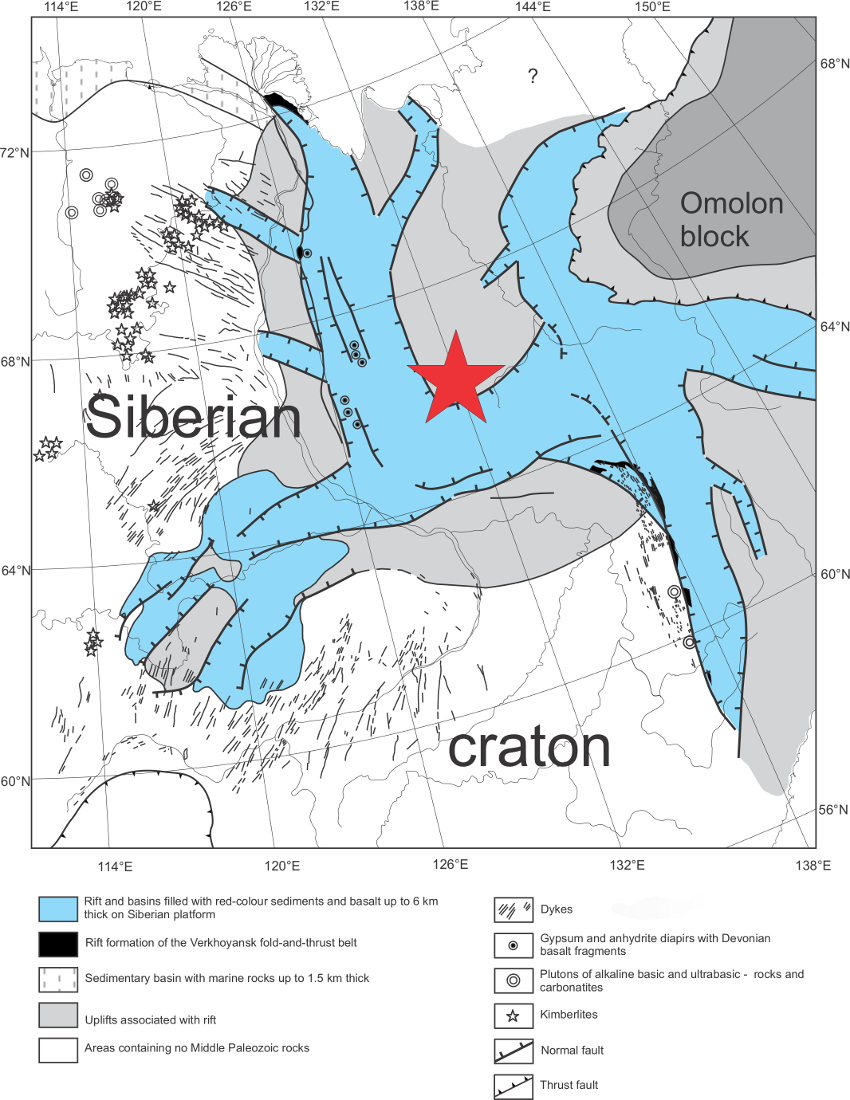
Figure 3: LIP record of Yakutsk-Vilyui LIP. After Polyansky et al. 2017 which was modified after Prokopiev et al. (2001) and Tretyakov (2004). Magmatism consists of volcanics along the rift systems (especially along the SW-trending Vilui rift system), and associated dyke swarms as mapped in the Siberian craton. A connection between the Omolon and Siberian cratons at this time has been proposed (e.g. Khain et al. 2009), however the details shown of the eastern part of the Devonian rift system are schematic. The star was added to locate plume centre at the approximate focus of the radiating dyke swarm and rift arms into the Siberian craton. Devonian magmatism in the Omolon craton is described in Fig. 4 and Section 2.2.
2.1 Yakutsk-Vilyui LIP (ca. 380-360 Ma), Siberian craton
The Yakutsk-Vilyui LIP comprises a giant radiating mafic dyke swarm and also radiating rift system (with 6 arms) converging to an interpreted mantle plume centre near the eastern margin of the Siberian craton (Shpount and Oleinkikov 1987; Fig. 3; Kiselev et al. 2012; Konstantinov et al. 2016; Polyansky et al. 2017, 2018; Tomshin et al. 2018). Mafic sills and volcanic rocks are preserved in the rifts, and the most significant rift is the main SW trending Vilyui rift system (Fig. 1; Masaitis et al. 2006; Kiselev et al. 2012; Polyansky et al. 2017). This LIP is associated with coeval carbonatites and kimberlites (that include many of the most diamondiferous kimberlites in Siberia). Recent U-Pb and Ar-Ar dating indicates pulses, at 374.1 ± 3.5 Ma, and 363.4 ± 0.7 Ma (Ricci et al. 2013; Polyansky et al. 2017, 2018).
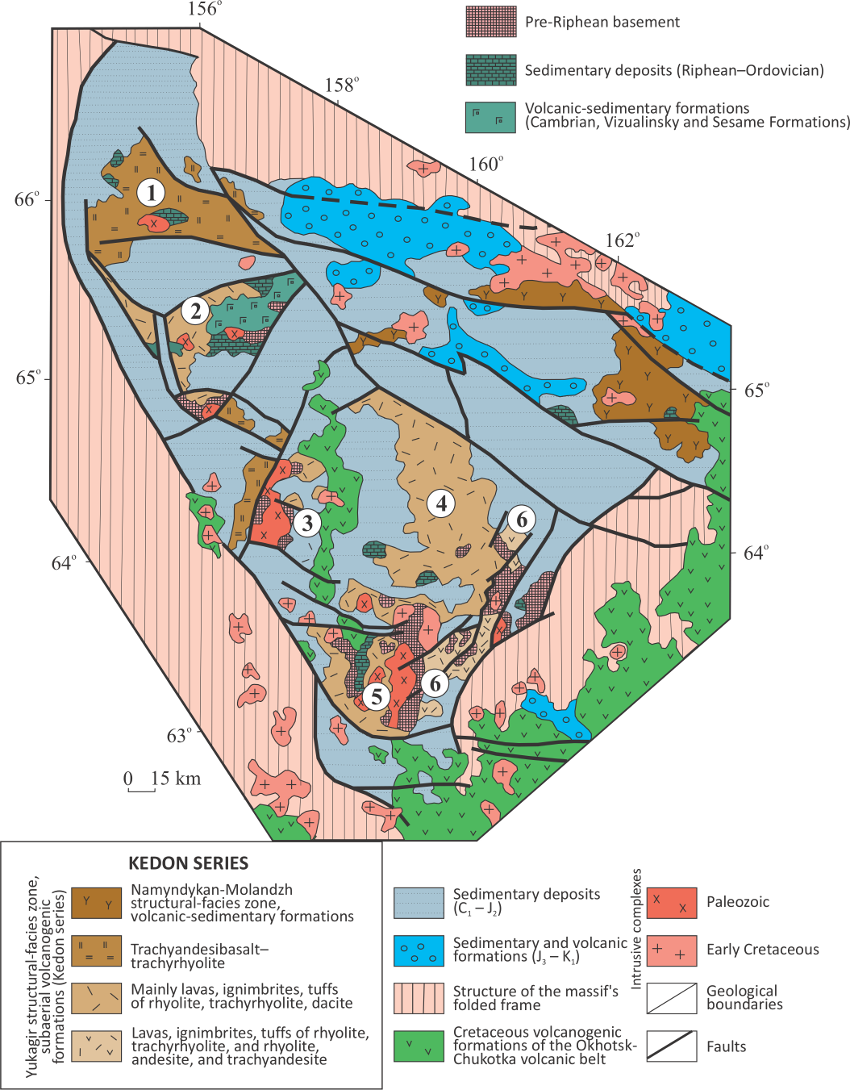
Figure 4: Geology of the Kedon series volcanic rocks, modified after (Gagieva, 2014). The numbers in circles indicate volcanic sections: 1 — Tokur-Yuryakh, 2 — Rassoshinsky, 3 — Abkitsky, 4 — Kedonsky, 5 — Oldyanin-Koargychansky; 6 — Anmandykan volcanic zone.
2.2 Kedon event (constrained between 400-345 Ma), Omolon craton
Devonian magmatism is also present in the Omolon craton (Fig. 4). The Kedon series volcanic rocks are distributed over an area of 400 x 200 km elongated in a NW-SE direction, and with a total area covered by volcanic rocks of about 13,000 km2 with an estimated volume of ≈ 21,000 km3 (Akinin and Miller, 2011; Gagieva 2014, 2016; Palymskiy and Goryachev 2015; Fig. 8.7 in Torsvik and Cocks 2017). The age of this volcanism has been determined by flora and fauna in host sedimentary rocks and broadly confirmed by isotope-geochemical methods (40Ar / 39Ar, Rb-Sr, U-Pb SHRIMP for detrital zircons) to be constrained between 400 to 345 Ma (Akinin and Miller 2011; Gagieva 2014, 2016; Palymskiy and Goryachev 2015).
The Kedon volcanism is inferred to be rift related and to be linked to same Middle Paleozoic plume (Yakutsk-Vilyui) which also led to the formation of the Middle Paleozoic Vilyui and Sette-Daban rifts in the Siberian craton (Fig. 4; Filatova and Khain 2007; Khain et al. 2009; Akinin and Miller 2011; Palymskiy and Goryachev 2015; Volkov et al. 2016; Gagieva 2016). However, the exact relationship with the Yakutsk-Vilyui LIP and plume is uncertain because of younger phases of folding-collision that have obscured the original connections between the Kedon magmatism of the Omolon craton and the Yakutsk-Vilyui LIP (Khain et al. 2009).
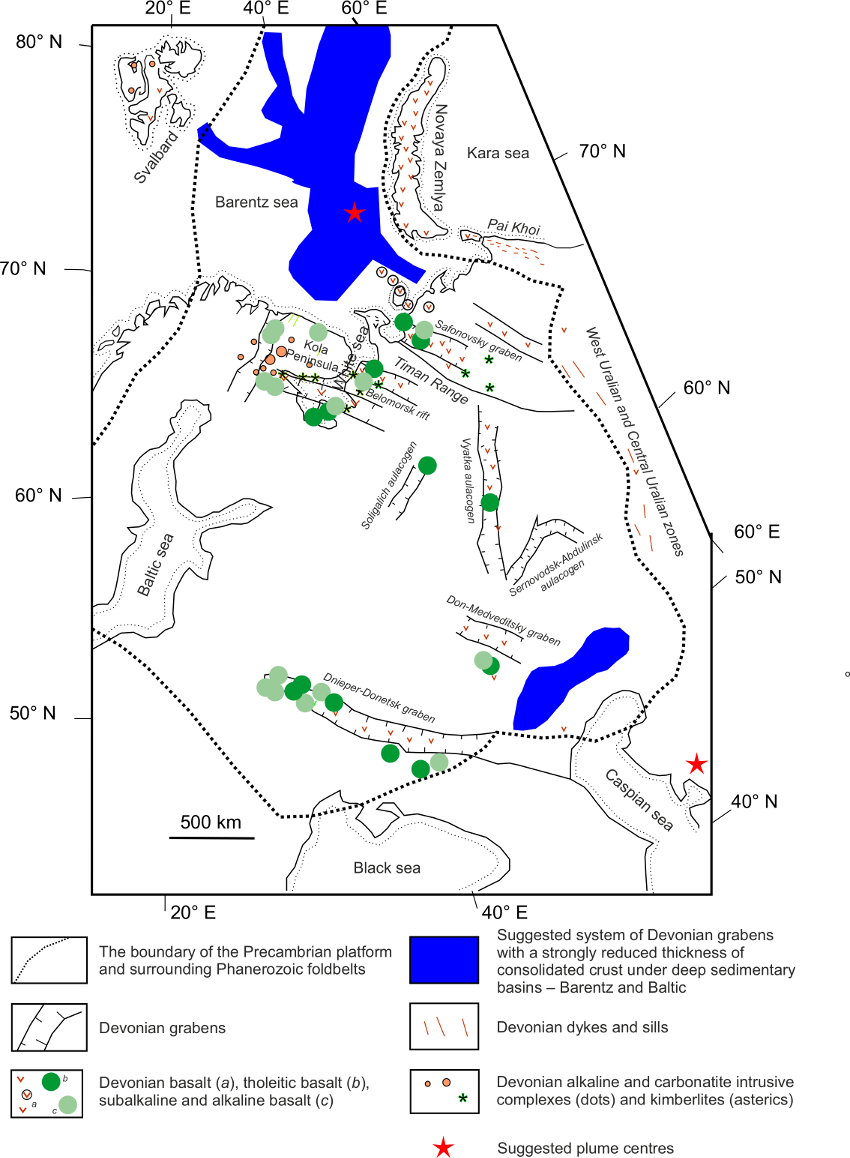
Figure 5: LIP record of Kola-Dnieper LIP and associated rifts of Baltica. After Puchkov et al. (2016) with additions from Yutkina et al. (2017).
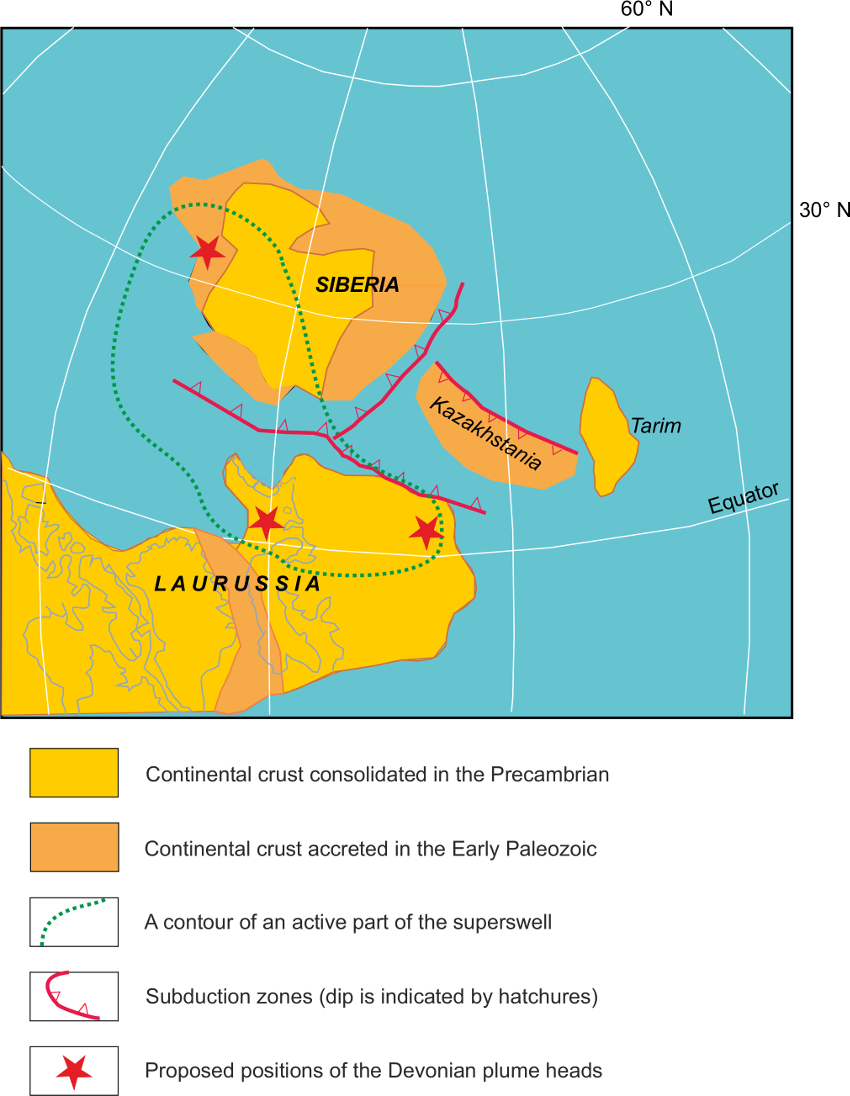
Figure 6: The 380-360 Ma Yakutsk-Vilyui plume centre and the two Kola-Dnieper plume centres in a Devonian reconstruction (after Puchkov et al. 2016). Separate line showing enclosing the three plume centres and representing a portion of the superswell in the deep mantle (Kuzmin et al. 2010, 2011) that is associated with this proposed Late Devonian superplume. Continental reconstruction modified after Abrajevitch et al. (2007); see also Scotese (2013).
2.3 Kola-Dnieper LIP (ca. 380-360 Ma)
A second major LIP with similar timing to the Yakutsk-Vilyui LIP of Siberia is located in Baltica (also termed the East European craton (Fig. 5). This extensive Devonian magmatic activity was widespread across Baltica (e.g. Nikishin et al. 1996; Fokin, 1998; Aizberg et al. 2001; Veiman et al., 2004; Veimarn and Korneeva 2007; Fig. 54 in Puchkov 2010; Fig. 11 in Stephenson et al. 2006; Arzamastsev et al. 2010; Fig. 7 in Ernst & Bell 2010; Terekhov et al. 2012; Kravchinsky 2012; Pease et al. 2016; Puchkov et al. 2016). Notably, this LIP includes coeval mafic magmatism of the Dnieper-Donets rift (Pripyat-Dnieper-Donets aulacogen), also a dyke swarm extending for 2000 km along the Urals, mafic magmatism in the Kola Peninsula and to the north in the Barents Sea, and scattered mafic magmatism elsewhere in the Baltic craton. Kimberlites (Archangelsk) and carbonatites (Kola Alkaline Province) are also associated with this LIP. This ca. 380–360 Ma LIP has been termed the Kola–Dnieper LIP (Ernst 2014) and was previously termed the East European Craton event (Ernst and Buchan 2001).
Two plume centres are recognized (Figs. 5, 6), one in the southern part of Baltica, to the SE of the E-W trending Dnieper-Donets rift, and in northern Baltica to the north of the Kola Peninsula (Puchov et al. 2016). The convergence of the Devonian dyke swarm along the Kola Peninsula coast (trending normal to the coast) and also the Pay-Khoy dyke swarm, as well as the presumed position of converging rifts/grabens in the Barents Sea suggests that this second Devonian plume centre may have been located in the East Barents Sea.
The southern plume centre is located at the extrapolated intersection of the Dnieper Donets aulacogen − a very large graben hosting two pulses of Late Frasnian and Late Famennian age mafic magmatism (Wilson and Lyashkevich 1996; Stephenson et al. 2006) − and the southern end of the Uralian dyke swarm of the Urals (Fig. 1). The relationship between these two proposed plume centres is discussed further in Puchkov et al. (2016).
2.4 Link of Yakutsk-Vilyui and Kola-Dnieper LIPs with Devonian biotic crises
Both the Yakutsk-Vilyui and the Kola-Dnieper LIPs provisionally seem to have the same age range and are reconstructed in close proximity and may be related to a single superplume (Figs. 5, 6; Puchkov et al. 2016). The two pulses which are most clearly identified in the Yakutsk-Vilyui LIP of Siberia (Fig. 4) have ages 374 Ma and 363 Ma, which are closely matched with the Kellwasser anoxia events (end Frasnian) and Annulata or Dasberg and Hangenberg anoxia events in the middle/late Famennian, respectively. The link with the Kellwasser events has been previously noted by a number of authors (e.g. Courtillot and Renne 2003; Polyansky et al. 2017, 2018; Courtillot et al. 2010; Ricci et al. 2013; Ogg et al. 2016).
Racki (1998) initially suggested a possible link with volcanism and rifting in Baltica were linked to the Frasnian-Famennian extinction. Then Kravchinsky et al. (2002) and Courtillot and Renne (2003) identified LIP events in both Baltica and Siberia, that we now label as the Kola Dnieper and Yakutsk-Vilyui LIPs (after Ernst 2014), to be the trigger of the end Devonian extinction. Recently, Racki et al. (2018) demonstrated that the mercury enrichments in the studied Devonian sections indicated that LIPs were the extinction trigger; however, the complex Hg pattern also suggested that it was not attributed to only one LIP, which is consistent with two candidates that we recognized (Yakutsk-Vilyui and Kola Dnieper).
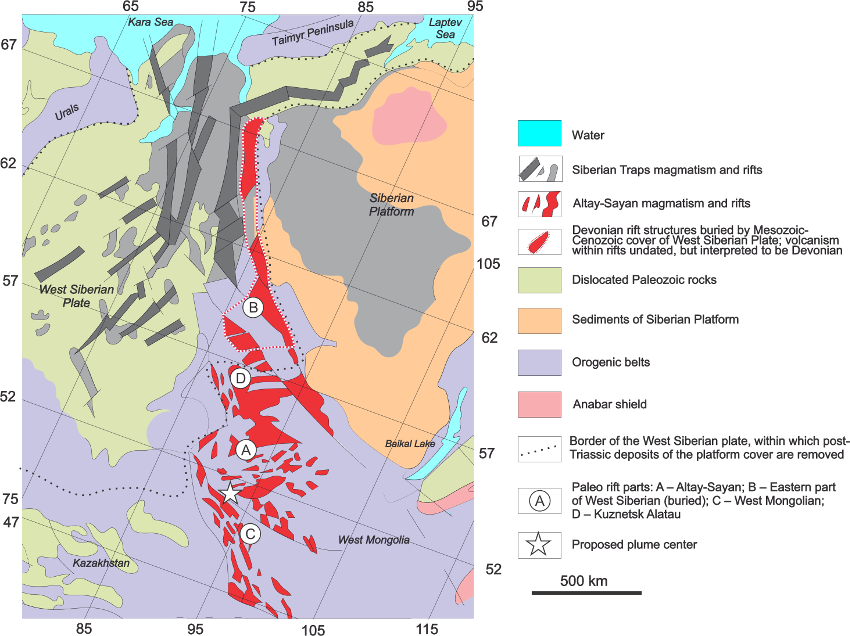
Figure 7: c. 400 Ma Altay-Sayan LIP of Siberia. Modified after Fig. 25 in Grinev (2007). Location of 252 Ma Siberian Traps LIP also shown. Location of main portions of the rift system (labelled with letters): Altai-Sayan (A), eastern part of West Siberian (buried) (B) and West Mongolian (C). The region in Kuznetsk Alatau (D) also contains c. 400 Ma alkaline intrusions that could be linked (Vrublevskii et al. 2019; Izokh et al. 2011). The plume centre (marked by star) is after Kuzmin et al. (2010). Buried Devonian rift system (in the northern part of the event) is after Surkov and Gerot (1981).
2.5 Altay-Sayan LIP (ca. 410-390 Ma)
Another large intraplate magmatic province of weakly alkaline affinity called the Altay–Sayan LIP is located in the Central Asian Orogenic belt of southeastern Siberia and is associated with a complex rift system, the Altay Sayan Rift System (Figs. 1, 7 and Table 1) (e.g. Yarmolyuk and Kovalenko 2003; Kuzmin et al. 2010; Kravchinsky 2012; Vorontsov et al. 1997, 2010, 2013; Izokh et al. 2011; Grinev 2014; Grinev et al., 2016, 2017; Yarmolyuk et al. 2014; Vrublevskii et al. 2019). The areal extent of magmatism is at least 0.35×106 km2 (Yarmolyuk et al. 2014) and the total volume is estimated to be at least 1 million km3 (unpublished estimate from O.M. Grinev).
On the basis of approximate ages, the magmatism may have spanned from Lower Devonian to Middle Devonian (over a period from about 490 to 400 Ma) with a peak from 408 to 393 Ma (Kuzmin et al. 2010; Kravchinsky 2012). Kravchinsky (2012) and suggesting a link with the end Silurian (start Devonian). There is sufficient uncertainty in the ages that this LIP could fall into the Lower Devonian close to 405 Ma in which case the event could be linked with the end of the graptolites and associated Chebbi or Atopus anoxia events near the base of the Emsian. Alternatively, if the true age was c. 390 Ma then the LIP could be linked with the c. 385-390 Ma group of anoxia events in the Eifelian or Givetian.
2.6 Additional intraplate events
The next section considers some additional small intraplate magmatic events that have age constraints in Devonian time.
2.6.1 Maritimes (Magdalen) basin event
Tholeiitic magmatism (up to 1.5 km thick) underlies the Maritimes basin of eastern Canada (Pe-Piper and Piper 1998; Dessureau et al. 2000), and was emplaced at the same time as convergent tectonics was occurring in the Canadian Appalachians. The model of Murphy et al. (1999; see also Murphy and Keppie 2005) suggests the arrival of a mantle plume that is initially prevented from reaching shallow levels by an intervening subducting plate. When the plume finally breached the subducting plate, the result was the Maritimes event (ca. 380–370 Ma with magmatism continuing to ca. 300 Ma). More precise dating is required to test the link of the identified magmatic pulses (ca. 380-370, ca. 360 and ca. 330 Ma) with biotic crises
2.6.2 Soltan Maidan Basaltic Complex event
The Soltan Maidan Basaltic Complex (SMBC) with thickness up to about 1300 m is located in the eastern Alborz zone, in northern Iran (Fig. 2; Derakhshi et al. 2017; see also Wendt et al. 2005). This complex is dominantly composed of transitional to mildly alkaline basaltic to basaltic andesite lava flows, agglomerates and tuffs, together with a few thin sedimentary interlayers. Field geological evidence and study of palynomorph assemblages in the shale interlayer show Late Ordovician to Lower-Upper Silurian ages. So, it is likely that parts of this event are too old for the Devonian period that we are considering herein, but precise dates are required to see whether there is an end Silurian or Devonian component of this Soltan Maidan LIP.
Wendt et al. (2002, 2005) describe some remnants of younger basaltic volcanic activity particularly from northern Iran, as minor basaltic intercalation in early Devonian (Padeha), late Devonian (Bahram/ Geirud) and early Carboniferous (Mobarak) sediments. The rocks are mostly described as basalt, diabase and dacite to andesite with flow package thicknesses up to 400 m. Mafic and ultramafic rocks occur in the Sanandaj-Sirjan Belt and near Anarak. Absolute ages for these magmatic pulses are not available, and the intraplate setting of this magmatism remains to be confirmed.
2.6.3 Selwyn Basin (NW North America) event
The Selwyn Basin hosts scattered alkaline mafic magmatism distributed over a length exceeding 1000 km and with a width of up to 300 km (Goodfellow et al. 1995; Fig. 1 in Goodfellow 2007; p. 146 in Torsvik and Cocks 2017). Three major episodes of mafic volcanism are identified, Early Cambrian, Middle Ordovician, and Middle to Late Devonian, and the volcanic rocks form discontinuous, lenticular belts that parallel rift-bounded faults or occur as isolated volcanic piles. The magmatism is linked to extension of the North American craton possibly in a back arc setting. A correlation is noted between these magmatic pulses, black shales and associated Zn-Pb-Ag sedimentary exhalative (SEDEX) ore deposits (Fig. 4 in Goodfellow 2007; Leybourne et al. 2018). Emsbo (2017) notes that middle Paleozoic SEDEX events (including in the Selwyn Basin) coincide with short-duration positive Sr-isotope excursions in the global marine record (also correlated with global d13C and d18O spikes, and periods of global anoxia), and conclude that these strong temporal correlations, supported by modeling, indicate the flux of radiogenic Sr-rich SEDEX brines was the likely cases of these prominent Sr-isotopic spikes that are not explained by oceanic models. Integrated with the magmatic link of Goodfellow (2007) mentioned above would suggest that Selwyn Basin alkaline magmatism contributed to Sr-rich SEDEX brines (also containing biolimiting nutrients and metals) released into the ocean may have triggered global chemical and biological events recorded in the sedimentary record.
References
Abrajevitch, A.V., Van der Voo, R., Levashova, N.M., Bazhenov, M.L., 2007. Paleomagnetism of the mid-Devonian Kurgasholak Formation, Southern Kazakhstan: constraints on the Devonian paleogeography and oroclinal bending of the Kazakhstan volcanic arc. Tectonophysics 441, 67–84.
Akinin, V.V., Miller, E. L., 2011. The evolution of calcareous-alkaline magmas of the Okhotsk-Chukchi volcanogenic belt. Petrology, 3. 249–290. [In Russian]
Aizberg, R.Y., Beskopylny, V.N., Starchik, Y.A., Tsekoyeva, T K., 2001. Late Devonian magmatism in the Pripyat Palaeorift: a geodynamic model. Geol. Quart. 45, 349–358.
Aleseev, A.S. 1998. Mass Extinctions at the Phanerozoic. Abstract of the Doctoral thesis.. Moscow: MSU, 76 p. [In Russian]
Algeo, T.J., Scheckler, S.E., 1998. Terrestrial-marine teleconnections in the Devonian: Links between the evolution of land plants, weathering processes, and marine anoxic events. Philosophical Transactions (B): Biological Sciences 353, 113-130, Royal Society of London.
Arzamastsev, A.A., Fedotov, Z.A., Arzamastseva, L.V., Travin, A.V., 2010: Paleozoic tholeiite magmatism in the Kola igneous province: spatial distribution, age, relations with alkaline magmatism. Doklady Earth Sciences 430, 205–209.
Becker, R.T., House, M.R., 2000. Devonian ammonoid zones and their correlation with established series and stage boundaries. Courier Forschungsinstitut Senckenberg, 169, 79–135.
Becker, R.T., Gradstein, F.M., Hammer, O., 2012. The Devonian Period. Chapter 22. In: F.M. Gradstein, J.G. Ogg, M.D. Schmitz, G.M. Ogg (eds.). The Geologic Time Scale 2012. Elsevier, pp. 559–601.
Becker, R.T., Königshof, P., Brett, C.E., 2016a. Devonian climate, sea level and evolutionary events: an introduction. In: Becker, R. T., Königshof, P. & Brett, C. E. (eds) 2016. Devonian Climate, Sea Level and Evolutionary Events. Geological Society, London, Special Publications, 423, 1–10.
Blackburn, T.J., Olsen, P.E., Bowring, S.A., McLean, N.M., Kent, D.V., Puffer, J.H., McHone, G., Rasbury, E.T., Et-Touhami, M., 2013. Zircon U–Pb geochronology links the end-Triassic extinction with the Central Atlantic Magmatic Province. Science 340, 941–945.
Bond, D.P.G., Grasby, S.E., 2017. On the causes of mass extinctions. Palaeogeography, Palaeoclimatology, Palaeoecology, 478, 3–29.
Burgess, S.D., Bowring, S.A., 2015. High-precision geochronology confirms voluminous magmatism before, during and after Earth's most severe extinction. Sci. Adv. 1 (7), e1500470. http://dx.doi.org/10.1126/sciadv.1500470.
Courtillot, V., Renne, P.R., 2003. On the ages of flood basalt events. Compt. Rendus Geosci. 335, 113–140.
Courtillot, V., Jaupart, C., Manighetti, I., Tapponier, P., Besse, J., 1999. On causal links between flood basalts and continental breakup. Earth and Planetary Science Letters 166, 177–195.
Courtillot, V.E., Kravchinsky, V.A., Quidelleuer, X., Renne, P.R., Gladkochub, D.P., 2010. Preliminary dating of the Viluyi traps (Eastern Siberia): eruption at the time of Late Devonian extinction events? Earth Planetary Science Letters 300, 239–245.
Davies, J.H.F.L., Marzoli, A., Bertrand, H., Youbi, N., Ernesto, M., Schaltegger, U., 2017. End-Triassic mass extinction started by intrusive CAMP activity. Nat. Commun. 8, 15596
Derakhshi, M., Ghasemi, H., Miao, L-C., 2017. Geochemistry and petrogenesis of Soltan Maidan basalts (E Alborz, Iran): Implications for asthenosphere-lithosphere interaction and rifting along the N margin of Gondwana. Chemie der Erde 77, 131-145.
Dessureau, G., Piper, D.J.W., Pe-Piper, G., 2000. Geochemical evolution of earliest Carboniferous continental tholeiitic basalts along a crustal-scale shear zone, southwestern Maritimes basin, eastern Canada. Lithos 50, 27–50.
Emsbo, P. (2017). Sedex brine expulsions to Paleozoic basins may have changed global marine 87Sr/86Sr values, triggered anoxia, and initiated mass extinctions. Ore Geology Reviews, v. 86, p. 474–486
Ernst, R.E. 2014. Large Igneous Provinces. Cambridge University Press 653.
Ernst, R.E., Bell, K., 2010. Large igneous provinces (LIPs) and carbonatites. Mineralogy and Petrology 98, 55–76.
Ernst, R.E., Youbi, N., 2017. How Large Igneous Provinces affect global climate, sometimes cause mass extinctions, and represent natural markers in the geological record: Palaeogeography, Palaeoclimatology, Palaeoecology, 478, 30-52.
Filatova, N.I., Khain, V.E., 2007. Tectonics of the Eastern Arctic. Geotectonics, 3. 3–29. [In Russian]
Fokin, P.?., 1998. Early Hercynian stage of development of the East European platform: Paleogeography and paleotectonics. The PhD thesis. Moscow, 332 p. [In Russian]
Gagieva A.M., 2014. Middle Paleozoic volcanism of the Omolon Massif (Northeast Asia): Chemical composition and geodynamic interpretation problems, Vestn. Otd. nauk Zemle, 6, NZ2001, doi:10.2205/2014NZ000122 [In Russian]
Gagieva, A.M., 2016. The Kedon series volcanics of the Middle Paleozoic as the Large Igneous Province (LIP) of the Omolon Massif. Geology, Geography, Biological Diversity and National Resources of North-East Russia. The 3rd Russian Conference in Commemoration of A.P. Vaskovsky and in Dedication of his 105th Birthday Date. Magadan, Oct. 12-14. 118–120. [In Russian].
Goodfellow, W.D., Cecile, M.P., Leybourne, M.I., 1995. Geochemistry, petrogenesis and tectonic setting of Lower Paleozoic alkalic and potassic volcanic rocks, northern Canadian Cordilleran Miogeocline. Canadian Journal of Earth Sciences 32, 1236– 1254.
Goodfellow, W.D., 2007, Base metal metallogeny of the Selwyn Basin, Canada, in Goodfellow, W.D., ed., Mineral Deposits of Canada: A Synthesis of Major Deposit-Types, District Metallogeny, the Evolution of Geological Provinces, and Exploration Methods: Geological Association of Canada, Mineral Deposits Division, Special Publication No. 5, p. 553-579.
Grinev, O.M., 2007. Rift Systems of Siberia: Methodology of Investigation, Morphotectonics, Minerageny. Tomsk, 433 p. [In Russian]
Grinev, O.M., 2014. Morphotectonics and magmatism of the West Mongolian-Gorny Altai-Kuznetsk zone of the Devonian depressions — a component of the Tuva-Minusinsk-West Siberian rift system. In: Altaide and Uralide Correlation: Magmatism, Metamorphism, Stratigraphy, Geochronology, Geodynamics, and Metallogenic Prediction. Materials of the second Russian-Kazakhstan international scientific meeting. Novosibirsk: SB R?S, pp. 37–39. [In Russian]
Grinev, O.M., Strakhov, ?.?., Bestemyanova, K.V., Grinev, R.O., 2016. Comparative morphotectonics of external and internal structures of the Rudny Altai mega trough. In Petrology of magmatic and metamorphic formations. Issue 8. Materials of the All-Russian Petrographic Conference with International participation. Tomsk: CNTI Press, pp. 93–107. [In Russian]
Grinev, O.M., Grinev, R.O., Bogorodov, ?.?., ?dylbaev, R.R., 2017. Geology and composition of the basalt-trachyte series of the Early Devonian of the Sarala graben (Khakassia). In Petrology of magmatic and metamorphic complexes. Issue 9. Materials of the IX All-Russian Petrographic Conference with international participation. Tomsk: CNTI Press, pp. 128–139. [In Russian]
Grinev, O.M, Vorontsov, A.A., Ernst, R.E., Perfilova, O.Y., 2019. Parameters and classification of the Devonian riftogenous Altai-Saransky LIP. Large Igneous Provinces through earth history: mantle plumes, supercontinents, climate change, metallogeny and oil-gas, planetary analogues. Abstract volume of the International Conference. Tomsk: CSTI Publishing house. – p. 45–46.
Izokh, A.E., Vishnevskii, A.V., Polyakov, G.V., Shelepaev, R.A., 2011. Age of picrite and picrodolerite magmatism in western Mongolia. Russian Geology and Geophysics 52, 7-23.
Kiselev, A.I., Ernst, R.E., Yarmolyuk, V.V., Egorov, K.N., 2012. Radiating rifts and dyke swarms of the middle Paleozoic Yakutsk plume of eastern Siberian craton. J. Asian Earth Sci., 45, 1–16.
Konstantinov, ?.?., Tomshin, ?.D., Ibragimov, Sh.Z., Khuzin, ?.Z., Konstantinov, I.K., Yakovlev, ?.?., Artemova, ?.V., 2016. Petro- and paleomagnetic studies of basalts of the Upper Devonian Appainskaya suite (Western Yakutia). Geodynamics & Tectonophysics 7 (4), 593–623. doi:10.5800/GT-2016-7-4-0224. [In Russian]
Kravchinsky, V.A., 2012. Paleozoic large igneous provinces of Northern Eurasia: Correlation with mass extinction events. Global and Planetary Change, 86-87, 31-36.
Kravchinsky, V.A., Konstantinov, K.M., Courtillot, V., Valet, J.-P., Savrasov, J.I., Cherniy, S.D., Mishenin, S.G., Parasotka, B.S., 2002. Palaeomagnetism of East Siberian traps and kimberlites: two new poles and palaeogeographic reconstructions at about 360 and 250 Ma. Geophysical Journal International 148, 1–33
Kuzmin, M.I., Yarmolyuk, V.V., Kravchinsky, V.A., 2010. Phanerozoic hot spot traces and paleogeographic reconstructions of the Siberian continent based on interaction with the African large low shear velocity province. Earth-Science Reviews 102, 29–59.
Leybourne, M.I., Van Wagoner, N., Paradis, S., Layton-Matthews, D., Moertle, J.A., 2018. Selwyn Basin magmatism and relationship to sediment-hosted Zn-Pb deposits; in Targeted Geoscience Initiative: 2017 report of activities, volume 2, (ed.) N. Rogers; Geological Survey of Canada, Open File 8373, p. 71–92. https://doi.org/10.4095/306603.
Masaitis, V.L., 2006. Devonian volcanism of the Patom–Vilyui aulacogen: multiple melting of inhomogeneous mantle sources. Russian Journal Regional Geology and Metallogeny 29, 27–49 [In Russian].
Murphy, J.B., van Staal, C.R., Keppie, J.D. 1999. Middle to late Paleozoic Acadian orogeny in the northern Appalachian: a Laramide-style plume-modified orogeny? Geology 27, 653–656.
Murphy, J.B., Keppie, J.D., 2005. The Acadian Orogeny in the Northern Appalachians. Int. Geol. Rev. 47, 663–687.
Nikishin, A.M., Ziegler, P.A., Stephenson, R.A., Cloetingh S.A., Furne A.V., Fokin P.A., Ershov A.V., Bolotov S.N., Korotaev M.V., Alekseev A.S., Gorbachev V.I., Shipilov E.V., Lankreijer A., Bembinova E.Yu., Shalimov I.V., 1996: Late Precambrian to Triassic history of the East European Craton: dynamics of sedimentary basin evolution. Tectonophysics 268, 23–63.
Ogg, J.G., Ogg, G.M., Gradstein, F.M., 2016. A Concise Geologic Time Scale 2016. Elsevier 243 pp. http://dx.doi.org/10.1016/B978-0-444-59467-9.00008-X.
Palymskiy, B.F., Goryachev, N.A., 2015. Volcanic Belts of the Okhotsk-Kolymski Region. Vestnik ONZ RAS, 1, 3–15. [In Russian]
Pease, V., Scarrow, J.H., Nobre Silva, I.G., Cambeses, A. 2016. Devonian magmatism in the Timan Range, Arctic Russia — subduction, post-orogenic extension, or rifting? Tectonophysics, 691, 185-197.
Pe-Piper, G., Piper D.J.W., 1998, Geochemical evolution of Devonian-Carboniferous igneous rocks of the Magdalen basin, eastern Canada: Pb- and Nd-isotope evidence for mantle and lower crustal sources: Canadian Journal of Earth Sciences, 35, 201-221.
Polyansky, O.P., Prokopiev, A.V., Koroleva, O.V., Tomsin, M.D., Reverdatto, V.V., Selyatitsky, A.Yu., Travin, A.V., Vasiliev, D.A., 2017. Temporal correlation between dyke swarms and crustal extension in the middle Proterozoic Vilyui rift basin, Siberian platform. Lithos, 282-283, 45-64.
Polyansky, O.P., Prokopiev, A.V., Koroleva, O.V., Tomshin, M.D. Reverdatto, V.V., Babichev, A.V., Sverdlova, V.G., Vasiliev, D.A., 2018. The nature of the heat source of mafic magmatism during the formation of the Vilyui rift based on the ages of dike swarms and results of numerical modeling. Russian Geology and Geophysics, 59, 1217-1236.
Prokopiev, A.V., Parfenov, L.M., Tomshin, M.D., Kolodeznikov, I.I., 2001. The cover of the Siberian Platform and adjacent fold-thrust belts. In: Parfenov, L.M., Kuz'min, M.I. (Eds.), Tectonics, Geodynamics, and Metallogeny of the Sakha Republic (Yakutia). Nauka/Interperiodika, Moscow, pp. 113–146 [In Russian].
Puchkov, V.N., 2010: Geology of the Urals and Cis−Urals (actual problems of the stratigraphy, tectonics, geodynamics an metallogeny), 280. Design Poligraph Service, Ufa. [In Russian].
Puchkov, V., Ernst, R.E., Hamilton, M.A., Söderlund, U., Sergeeva, N., 2016. A Devonian >2000-km long dolerite swarm-belt and associated basalts along the Urals-Novozemelian fold-belt: part of an East-European (Baltica) LIP tracing the Tuzo Superswell. GFF, 138, 6-16, 10.1080/11035897.2015.1118406
Racki, G., Rakocinski, M., Marynowski, L., Wignall, P.B., 2018. Mercury enrichments and the Frasnian-Famennian biotic crisis: A volcanic trigger proved? Geology 46 (6), 543–546.
Ricci, J., Quidelleur, X., Pavlov, V., Orlov, S., Shatsillo, A., Courtillot, V., 2013. New 40Ar/39Ar and K-Ar ages of the Viluy traps (Eastern Siberia): Further evidence for a relationship with the Frasnian-Famennian mass extinction: Palaeogeography, Palaeoclimatology, Palaeoecology 386, 531-540.
Schoene, B., Eddy, M.P., Samperton, K.M., Keller, C.B., Keller, G., Adatte, T., Khadri, S.F.R., 2019. U-Pb constraints on pulsed eruption of the Deccan Traps across the end-Cretaceous mass extinction. Science 363, 862–866.
Scotese, C.R., 2013: Map Folio 67, Late Devonian, (379.9 Ma, Frasnian), PALEOMAP PaleoAtlas for ArcGIS, volume 4, Late Paleozoic, PALEOMAP Project, Evanston, IL.
Shpount, B.R., Oleinkikov, B.V., 1987. A comparison of mafic dyke swarms from the Siberian and Russian platforms. In Halls, H.C. & Fahrig, W.F. (eds.), Mafic Dyke Swarms. Geological Association of Canada, Special Paper 34, pp. 393–400.
Sprain, C.J., Renne, P.R., Vanderkluysen, L., Pande, K., Self, S., Mittal, T., 2019. The eruptive tempo of Deccan volcanism in relation to the Cretaceous-Paleogene boundary. Science, 363 (6429), 866-870.
Stephenson, R.A., Yegorova T., Brunet, M-F., Stovba S., Wilson M., Starostenko V., Saintot A., Kusznir N., 2006: Late Palaeozoic intra- and pericratonic basins on the East European Craton and its margins. In D.G. Gee & R.A. Stephenson (eds.): European lithosphere dynamics, Geological Society, London, Memoirs 32, 463–479.
Surkov, V.S., Gerot, O.G., 1981. The foundation and development of the platform cover of the West Siberian Plate. - Moscow: Nedra, 143 p. [In Russian]
Tomshin, M.D, Kopylova, A.G., Konstantinov, K.M., Gogoleva, S.S., 2018. Basites of the Vilyui paleorift: geochemistry and sequence of intrusive events. Russ. Geol. Geophys. 59, 1204–1216.
Tretyakov, F.F., 2004. Mid-Paleozoic rift structures at the base of the Verkhoyansk fold belt. Otechestvennaya Geologiya 4, 57–60 [In Russian].
Torsvik, T.H., Cocks, L.R.M. 2017. Earth History and Palaeogeography. Cambridge University Press, 332 p.
Veimarn A.B., Korneeva S.A., 2007. Global geological events at Frasnian/Famennian boundary. Bulletin MOIP. Geol. branch. 82 (1), 48–68.
Veimarn, A.B., Puchkov, V.N., Abramova, A.N., et al., 2004: Stratigraphy and geological events at the Frasnian-Famennian boundary in the Southern Urals. Geological Quarterly 48, 233–244.
Volkov, A.V., Sidorov, A.A., Savva, N.E., Prokofiev, V.Yu, Kolova, E.E., Murashov, K.Yu., Zemskova, M.I., 2016. Features of epithermal ore formation in the Kedon Palaeoizoic volcano-plutonic belt of Northeast of Russia, according to the data of geochemical studies of Au – Ag ore mining. Volcanology and Seismology. No. 6. 3–21. [In Russian]
Vorontsov, A.A., Yarmolyuk, V.V., Ivanov, V.G., Sandimirova, G.P., Pakholchenko, Y.A., 1997. Sources of basaltic melts for Devonian rift bimodal igneous associations of central Asia: evidence from trace-element and strontium isotopic data on basic rocks from northeastern Mongolia. Petrology 5 (3), 208–222.
Vorontsov, A.A., Yarmolyuk, V.V., Fedoseev, G.S., Nikiforov, A.V., Sandimirova, G.P., 2010. Isotope-geochemical zoning of the Devonian magmatism in the Altay-Sayan rift area: to the evaluation of the composition and geodynamic nature of the mantle magmatic sources. Petrology 18 (6), 596–609.
Vorontsov, A.A., Andryushchenko, S.V., Fedoseev, G.S., 2013. Devonian volcanism in the Minusa basin in the Altai-Sayan area: geological, geochemical, and Sr–Nd isotopic characteristics of rocks. Russ. Geol. Geophys. 54 (9), 1001–1025.
Vrublevskii, V.V., Gertner, I.F., Ernst, R.E., Izokh, A.E., Vishnevskii, A.V., 2019. The Overmaraat-Gol Alkaline Pluton in Northern Mongolia: U–Pb Age and Preliminary Implications for Magma Sources and Tectonic Setting. Minerals, 9(3), 170; https://doi.org/10.3390/min9030170
Walliser O.H., 1996. Global events in the Devonian and Carboniferous / Ed. O.H. Walliser. Global events and event stratigraphy in the Phanerozoic. Berlin, Heidelberg, Springer, pp. 225—250.
Wendt, J., Kaufmann, B., Belka, Z., Farsan, N. and Karimi Bavandpur, A., 2002. Devonian/ Lower Carboniferous stratigraphy, facies patterns and palaeogeography of Iran. Part I. Southeastern Iran. Acta Geologica Polonica 52 (2), 129-168.
Wendt, J., Kaufmann, B., Belka, Z., Farsan, N., Bavandpur, A.K., 2005. Devonian/Lower Carboniferous stratigraphy, facies patterns and palaeogeography of Iran. Part II. Northern and central Iran. Acta Geologica Polonica 55, 31-97.
Wilson, M., Lyashkevich, Z.M., 1996: Magmatism and the geodynamics of rifting of the Pripyat-Dnieper-Donets rift, East European Platform. Tectonophyiscs 268, 65–81.
Yarmolyuk, V.V., Kovalenko, V.I., 2003. Deep geodynamics and mantle plumes: role in formation of the Central-Asian folded belt. Petrology 1 (6), 504–531.
Yarmolyuk, V.V., Kuzmin, M.I., Ernst, R.E., 2014. Intraplate geodynamics and magmatism in the evolution of the Central Asian Orogenic Belt: Journal of Asian Earth Sciences, 93, 158–179. doi: 10.1016/j.jseaes.2014.07.004.
Yutkina, E.V., Nosova, ?.?., Sazonova, L.V. et al., 2017. Devonian volcanics of the Voronezh crystalline massif, East European Platform: Evolution of melts and peculiarities of crustal contamination. Petrology, 25 (3): 233–264. [In Russian]
